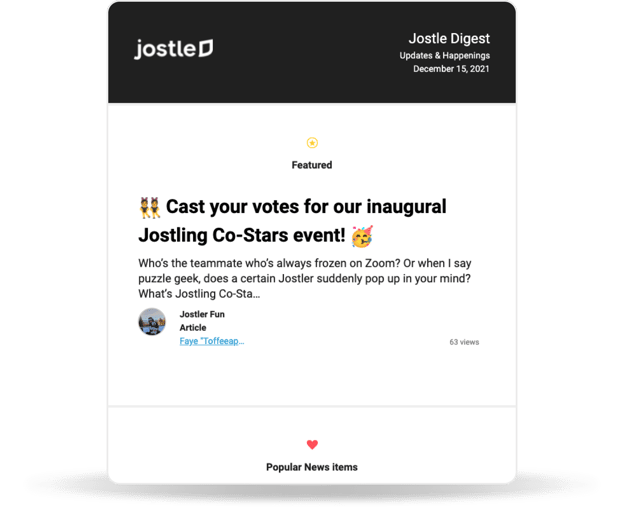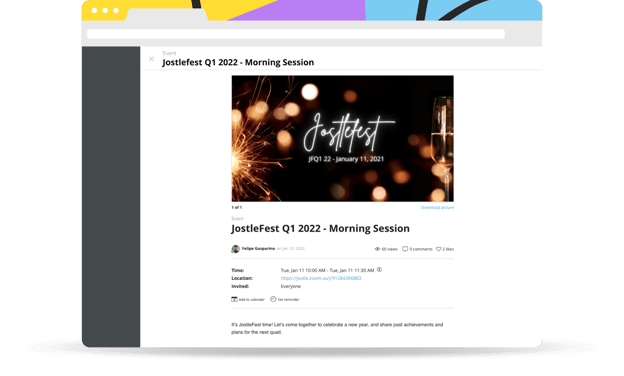By Faye Wai
9 min read

There isn’t really a standardized formula for effective internal communications. You might be following best practices, but even the most seasoned communications professional needs some concrete inspiration from time to time.
Holding the attention of your people is more of an art form than a science, after all. Plus, your internal communications significantly impact your employee experience, so its importance can’t be understated.
In this article, we’ll be sharing 10 internal communication examples that we’ve implemented at Jostle. We hope you'll reflect on areas that could use some improvement or incorporate these ideas into your own organization's communications mix.
10 internal communication ideas and examples
1. Shape up your internal documentation and accessibility
2. Start a company bulletin or newsletter
3. Share company successes and recognize accomplishments
4. Launch company-wide town halls and CEO “ask me anything”
5. Collect regular feedback from different perspectives
6. Welcome new hires so people can make them feel at home
7. Streamlined event management and promotion
Internal communication tips to keep in mind
Target the right audience so information is relevant
Make sure information is consistent across the board
How robust is the internal documentation of your company's processes, policies, and other important company information? If these documents already exist, your people need a reliable place to locate it all to streamline your internal communications.
Here at Jostle, we keep our key information in a shared knowledge file repository that’s easily accessible to those who need them. These widely available resources include onboarding materials, brand books for vendors, the latest office policies, and much more. Not only is this is incredibly useful when it comes to working asynchronously, but it ensures that execution is consistent across your organization.
Content for self-directed learning can also be stored in your shared library. Thay way, your people can take learning into their own hands, so they're continuously developing their skills and knowledge.
Launch a company newsletter or bulletin that you release on a regular basis, such as weekly or monthly. Everyone in your organization can then stay informed about notable news, events, or updates. You can even mention upcoming employee birthdays or anniversaries so that everyone can share their well wishes.

To streamline your processes, consider automating these communications. At Jostle, our company bulletin is automated monthly by snapshotting our internal communication platform's org-wide activity feed and news highlights.
Your culture falls flat when your people aren't celebrated. Be sure to publically recognize your employees' achievements and give credit where credit’s due. Spotlight promotions and celebrate when sales revenue metrics go up. Shed light on any processes improved by the customer success team, or distribute information about the recently upgraded benefits scheme.
To foster transparency and alignment, you need to create channels and venues for your employees to raise questions with leadership. This could look like a company "town hall meeting" or even an "ask me anything" chat group.
For instance, JostleFest is where the whole company shares quarterly project plans, hindsight progress, and celebrates wins. During the event, team leads present the results of their completed projects and we look forward to key milestones ahead. People outside of those departments can ask questions, see new feature demos, and most importantly, ask questions to improve alignment.
Outside of JostleFest, we also have an org-wide discussion called “Ask Brad Anything”. There, Jostlers can send our CEO a question, and he’ll answer it openly so everyone can follow along or chime in. Anyone can ask a question, on any topic.
Open-door policies and communication channels help people express how they feel in real-time. Of course, it’s also up to leaders to organize regular pulse surveys and polls and proactively invite feedback.
Collecting feedback can be done on a regular basis or ad hoc, depending on the circumstance and insight you need. Not only does this shows how much you respect people’s opinions, but this effectively strengthens communication across the organization.
A quarterly check-in or follow-up survey is a great way to continue these conversations. You can also include the survey results in a news article or company newsletter, so everyone stays in the loop.
The first day for a new hire is usually wrapped up in excitement but a little nervousness too. Help new hires feel welcome by publishing an internal article before their first day. Not only does this provide a space where existing employees can share well wishes, they can also stay updated on who's new and what teams are growing.

You can also ask new employees to post their own news article in their first week. This serves a few other internal communication purposes too, like helping newcomers feel comfortable using our tools, gives them a chance to share a bit about their experience and interests, and adds a new voice to our company culture.
Manage your company events in the same place, with the same processes—whether it's in-person or virtual. That way, your great employees will always know when upcoming events are, how to locate them, and when RSVP deadlines are.

Your event details should always mention the goal, agenda, relevant meeting links, plus the time and location. Hosting events is a great internal communication opportunity to keep everyone informed. You don't want your employees missing out because your systems aren't streamlined.
Create communication channels that socially engage everyone in your organization, even frontline workers. For instance, at Jostle, we have a "watercooler" instant messaging channel that simulates impromptu conversations unrelated to work.

To automate our processes, we've even synced our chat with a spreadsheet of question prompts using Zapier, so it will keep the channel active each day. The result? More social connection and employee engagement at work, even with people who might not always be at the office.
Monitoring industry news isn’t just a one-person effort. Everyone should keep up with the latest scoop and be aware of the current landscape. This could be competitor news releases, the latest marketing updates, or interesting customer insights. We use an instant messaging channel to circulate reliable blogs, links, and resources that everyone can contribute to.
Knowing all the reasons why we’re tired of video meetings means we should change up our communication formats regularly. Leaders should experiment with different meeting formats (hybrid, in-person, virtual), instant messaging chats, recorded video, and others.
During the org-wide JostleFest, we've experimented with both virtual and in-person meetings. We've even switched up how many people participate in a meeting or break out into smaller teams for specific exercises. The outcome? People are more eager to contribute in smaller group environments, retain information better, and feel more connected to the organization.
Good storytelling goes far in nearly any organization because, well, everyone loves a good story. A story doesn’t have to be detailed to communicate critical information effectively; it can be as simple as an introduction. Turning internal messages into compelling stories that reflect your company’s values isn’t only effective; it’s easier than you think.
But anything can be turned into a compelling story. A quarterly newsletter, for instance, is essentially a story about what happened in your organization over the previous quarter. Jazz it up a bit so that it’s more relatable to your people.
Effective internal communications is more than announcing events and news, posting lists of figures, and screenshots of quarterly reports. To hold your people’s attention, your updates need to be interesting. Companies with great internal communications know this and incorporate thought-provoking or fun updates into their internal communications strategy.
Remember: employee communications hit a massive roadblock when team members aren’t interested in or can’t find the content you want them to see. Give the people what they want!
Keeping your people interested usually means posting what they want to see or read in their preferred tone. Suppose you’re a communications professional at a more traditional law firm (strict dress code, traditional org structure, business above all else), for example. In that case, quarterly reports and lists of figures might be fine. But if your company’s a graphic design agency with an open office plan and bean bag chairs scattered about, maybe memes are more your style.
Tone should almost always be an important consideration when composing an update that goes out to your organization. Here are a few aspects you should think about:
Imagine being looped into things that aren’t significant to your job or something you’re just not interested in. It doesn’t feel good being overwhelmed with spam and unnecessary information.
And as we said before, with Zoom fatigue, “the medium is the message”, so choose your communication channels and media with care. The next step is to identify the necessary people involved: who are the meeting participants? Does Sophie have to sit in this meeting? Can I replace relay a message with a written summary instead of piling on more meetings?
Similar to your external brand, you want to ensure you’re showing up consistently to your employees. If one document says one thing, but your verbal update says another, this can cause confusion (and, let’s face it, frustration). Keeping internal documentation up to date, detailed, and easy to find is vital here.
We hope these internal communication examples have sparked some creativity that you can run with. But of course, acknowledge that researching what's best within your own organization is what's most important.
One of the best things you can do as you’re developing your internal communications strategy is to poll your people to see what kind of content they’d be interested in. This is also an excellent way to check out the vibe of your organization and adapt your tone accordingly. Good luck with all your alignment endeavors!
Read more by
Faye Wai
Jostle’s employee success platform is where everyone connects, communicates, and celebrates at work. Find out more at jostle.me. © 2009–2025 Jostle Corporation. All rights reserved.